Method Article
Characterization of Intra-Cartilage Transport Properties of Cationic Peptide Carriers
W tym Artykule
Podsumowanie
This protocol determines equilibrium uptake, depth of penetration and non-equilibrium diffusion rate for cationic peptide carriers in cartilage. Characterization of transport properties is critical for ensuring an effective biological response. These methods can be applied for designing an optimally charged drug carriers for targeting negatively charged tissues.
Streszczenie
Several negatively charged tissues in the body, like cartilage, present a barrier to the targeted drug delivery due to their high density of negatively charged aggrecans and, therefore, require improved targeting methods to increase their therapeutic response. Because cartilage has a high negative fixed charge density, drugs can be modified with positively charged drug carriers to take advantage of electrostatic interactions, allowing for enhanced intra-cartilage drug transport. Studying the transport of drug carriers is, therefore, crucial towards predicting the efficacy of drugs in inducing a biological response. We show the design of three experiments which can quantify the equilibrium uptake, depth of penetration and non-equilibrium diffusion rate of cationic peptide carriers in cartilage explants. Equilibrium uptake experiments provide a measure of the solute concentration within the cartilage compared to its surrounding bath, which is useful for predicting the potential of a drug carrier in enhancing therapeutic concentration of drugs in cartilage. Depth of penetration studies using confocal microscopy allow for the visual representation of 1D solute diffusion from the superficial to deep zone of cartilage, which is important for assessing whether solutes reach their matrix and cellular target sites. Non-equilibrium diffusion rate studies using a custom-designed transport chamber enables the measurement of the strength of binding interactions with the tissue matrix by characterizing the diffusion rates of fluorescently labeled solutes across the tissue; this is beneficial for designing carriers of optimal binding strength with cartilage. Together, the results obtained from the three transport experiments provide a guideline for designing optimally charged drug carriers which take advantage of weak and reversible charge interactions for drug delivery applications. These experimental methods can also be applied to evaluate the transport of drugs and drug-drug carrier conjugates. Further, these methods can be adapted for the use in targeting other negatively charged tissues such as meniscus, cornea and the vitreous humor.
Wprowadzenie
Drug-delivery to negatively charged tissues in the body remains a challenge due to the inability of drugs to penetrate deep into the tissue to reach cell and matrix target sites1. Several of these tissues comprise of densely-packed, negatively-charged aggrecans which create a high negative fixed charge density (FCD)2 within the tissue and act as a barrier for the delivery of most macromolecules3,4. However, with the assistance of positively charged drug carriers, this negatively charged tissue barrier can actually be converted into a drug depot via electrostatic charge interactions for sustained drug delivery1,5,6,7(Figure 1).
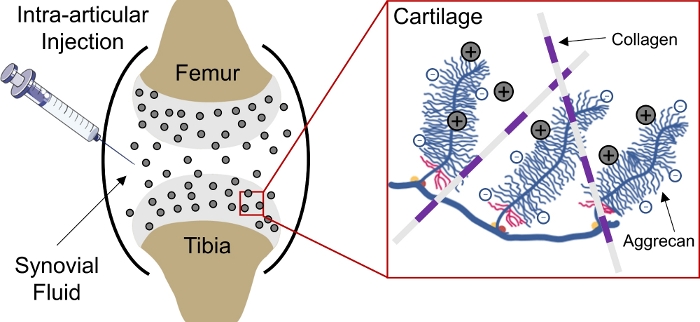
Figure 1: Charge based intra-cartilage delivery of CPCs. Intra-articular injection of CPCs into the knee joint space. Electrostatic interactions between positively charged CPCs and negatively charged aggrecan groups enable rapid and full depth penetration through cartilage. This figure has been modified from Vedadghavami et al4. Please click here to view a larger version of this figure.
Recently, short-length cationic peptide carriers (CPCs) were designed with the goal of creating small cationic domains capable of carrying larger sized therapeutics for delivery to the negatively charged cartilage4. For effective drug delivery to the cartilage for treating prevalent8,9 and degenerative diseases such as osteoarthritis (OA)10, it is critical that therapeutic concentrations of drugs penetrate deep within the tissue, where a majority of the cartilage cells (chondrocytes) lie11. Although there are several potential disease modifying drugs available, none have gained FDA approval because these are unable to effectively target the cartilage12,13. Therefore, evaluation of the transport properties of drug carriers is necessary for predicting the effectiveness of drugs in inducing a therapeutic response. Here, we have designed three separate experiments that can be utilized for assessing the equilibrium uptake, depth of penetration and non-equilibrium diffusion rate of CPCs4.
To ensure that there is a sufficient drug concentration within the cartilage that can provide an optimal therapeutic response, uptake experiments were designed to quantify equilibrium CPC concentration in cartilage4. In this design, following an equilibrium between the cartilage and its surrounding bath, the total amount of solute inside the cartilage (either bound to the matrix or free) can be determined using an uptake ratio. This ratio is calculated by normalizing the concentration of solutes inside the cartilage to that of the equilibrium bath. In principle, neutral solutes, whose diffusion through the cartilage is not assisted by charge interactions, would have an uptake ratio of less than 1. Conversely, cationic solutes, whose transport is enhanced via electrostatic interactions, show an uptake ratio greater than 1. However, as shown with CPCs, use of an optimal positive charge can result in much higher uptake ratios (greater than 300)4.
Although high drug concentration within the cartilage is important for achieving therapeutic benefit, it is also critical that drugs diffuse through the full thickness of the cartilage. Therefore, studies showing the depth of penetration are required to ensure that drugs reach deep within the cartilage so that the matrix and cellular target sites can be reached, thereby providing a more effective therapy. This experiment was designed to assess the one-way diffusion of solutes through cartilage, simulating diffusion of drugs into cartilage following intra-articular injection in vivo. Fluorescence imaging using confocal microscopy allows for the evaluation of depth of penetration into cartilage. Net particle charge plays a key role in moderating how deep drugs can diffuse through the matrix. An optimal net charge based on a tissue FCD is required to allow for weak-reversible binding interactions between cationic particles and the anionic tissue matrix. This implies that any interaction is weak enough so that particles can disassociate from the matrix but reversible in nature so that it can bind to another matrix binding site deeper within the tissue4. Conversely, excessive positive net charge of a particle can be detrimental towards diffusion, as too strong matrix binding prevents detachment of particles from the initial binding site in the superficial zone of cartilage. This would result in an insufficient biological response as a majority of the target sites lie deep within the tissue11.
To further quantify the strength of the binding interactions, analysis of drug diffusion rates through cartilage is advantageous. Non-equilibrium diffusion studies allow for the comparison of real-time diffusion rates between different solutes. As drugs diffuse through the superficial, middle and deep zones of cartilage, the presence of binding interactions can greatly alter diffusion rates. When binding interactions are present between drugs and the cartilage matrix, it is defined as the effective diffusivity (DEFF). In this case, once all binding sites have been occupied, the diffusion rate of drugs is governed by the steady-state diffusion (DSS). Comparison between the DEFF of different solute determines the relative binding strength of solutes with the matrix. For a given solute, if the DEFF and DSS are within the same order of magnitude, it implies that there is minimal binding present between the drug and matrix during diffusion. However, if DEFF is greater than DSS, substantial binding of particles to matrix exists.
The designed experiments individually allow for the characterization of solute transport through the cartilage, however, a holistic analysis inclusive of all results is required for designing an optimally charged drug carrier. The weak and reversible nature of charge interactions controls particle diffusion rate and allows for high equilibrium uptake and rapid full depth penetration through cartilage. Through equilibrium uptake experiments, we should look for carriers that show high uptake as a result of charge interactions which can be verified using non-equilibrium diffusion rate studies. However, these binding interactions should be weak and reversible in nature to allow for full-thickness penetration of the solute through cartilage. An ideal drug carrier would possess an optimal charge which enables strong enough binding for uptake and high intra-cartilage drug concentrations, but not too strong as to impede full-thickness diffusion4. The presented experiments will assist in the design characteristics for charge-based tissue targeting drug carriers. These protocols were used for characterizing CPC transport through cartilage4, however, these can also be applied to a variety of drugs and drug carriers through cartilage and other negatively charged tissues.
Protokół
University approvals were obtained for conducting the experiments with dead tissues. Bovine joints were obtained commercially from a slaughterhouse.
1. Cartilage explant extraction
- Using a scalpel (#10 blade), cut and remove fat, muscles, ligaments, tendons and all other connective tissue to expose the cartilage from the femoropatellar groove of bovine knee joints.
- Using 3 mm and 6 mm dermal punches, make perpendicular punches into the cartilage to extract cylindrical plugs. Immediately place the plugs in individual wells of a 48-well plate containing 500 μL of 1x phosphate buffered saline (PBS) supplemented with 1% v/v antibiotic-antimycotic.
- Place the superficial side of a cartilage plug facing down into a well in the slicing fixture (Figure 2). Using a razor blade, slice the plug along the surface of the slicing fixture to obtain a 1 mm thick cartilage explant that is inclusive of the superficial zone. Repeat for each cartilage plug.
- Store cartilage explants individually in polypropylene tubes containing 500 μL of 1x PBS supplemented with protease inhibitors (PBS-PI, 1 PI mini-tablet per 50 mL 1x PBS) at -20 °C.
- Prior to conducting each of the following transport experiments, thaw the explant-containing vials for 30 min in a 37 °C water bath.
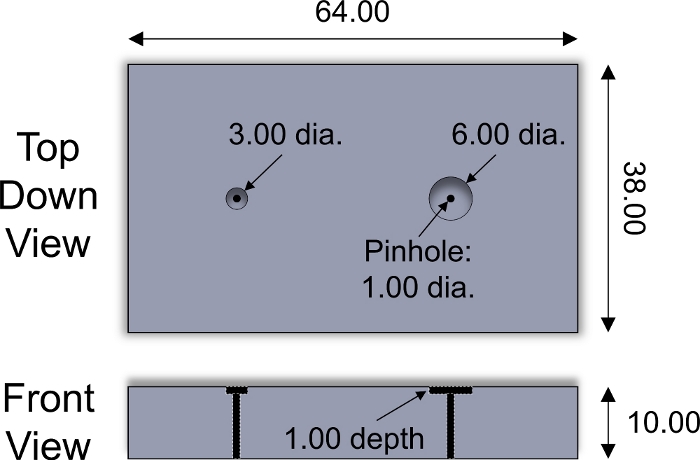
Figure 2: Custom-designed slicing fixture. Design parameters of stainless steel slicing fixture used for slicing cartilage explants of 3 and 6 mm diameter. Plastic inserts of varying thickness were placed inside wells to adjust the thickness of sliced explants. Stainless steel cylindrical pin of <1 mm diameter was used to push explant out of fixture. All numerical values are presented in mm. Please click here to view a larger version of this figure.
2. Equilibrium uptake of CPCs in cartilage
- Gently dab cartilage explants (3 mm dia. X 1 mm thick.) with a delicate task wipe to remove excess 1x PBS from the explant surface. Using a balance, quickly record the wet weight of each explant and then immediately place in a 1x PBS bath to prevent dehydration.
- Prepare 30 μM solutions (300 μL per explant) of fluorescently labeled CPCs in 1x PBS-PI. Use RNase-free polypropylene tubes for reconstitution.
- In a 96-well plate, pipette 300 μL of each 30 μM CPC solution into separate wells. Avoid using wells near the edge of the plate to prevent evaporation. Using a spatula, transfer each explant to the solution containing wells.
- Fill surrounding wells with 300 μL of 1x PBS and cover the well plate with lid. Seal the edges of the plate with flexible film to minimize evaporation.
- Inside of a 37 °C incubator, place the plate on a plate shaker to limit the particle sedimentation. Incubate for 24 h under gentle rotation (50 rpm with a 15 mm orbit) to allow for the equilibrium uptake of CPCs in the cartilage (Figure 3).
- Generate a standard curve for correlation of fluorescence to CPC concentration
- Prepare serial dilutions of CPC solutions from 30 μM – 0 μM (10 2-fold dilutions) in 1x PBS-PI in polypropylene tubes. Ensure that at least 500 μL of each dilution is present.
- Add 200 μL of each dilution to consecutive wells in a black 96-well plate. Duplicate in another row to increase sample size.
- Obtain fluorescence readings of each sample using a plate reader at the excitation and emission wavelengths of the fluorescent label using a plate reader.
- Plot fluorescence reading vs. CPC concentration and derive an equation for the linear portion of the curve.
NOTE: To limit the variability in fluorescence readings, incubate the CPC stock solution under the same conditions as the sample plate prior to generation of the standard curve.
- After 24 h of incubation, collect the equilibrium bath from each well in separate polypropylene tubes.
- Transfer 200 μL of each solution into separate wells of a black 96-well plate. Obtain fluorescence readings of each sample under the same fluorescent settings as for the standard curve. If necessary, dilute the sample in 1x PBS-PI to ensure readings fall within the linear portion of the standard curve.
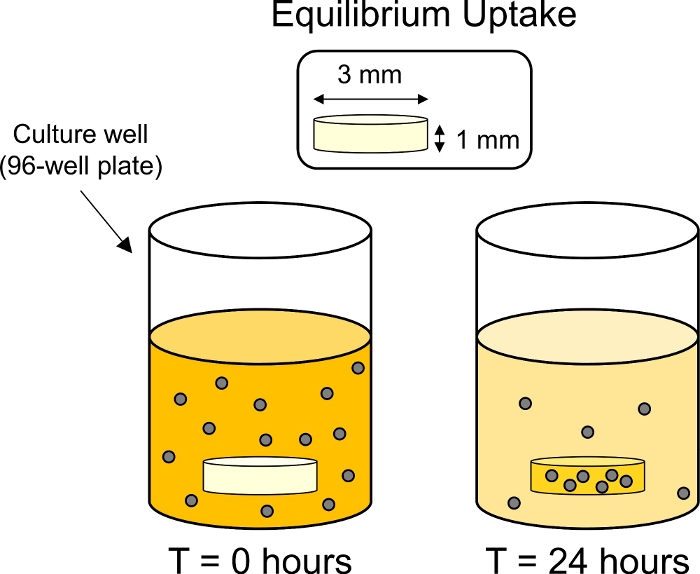
Figure 3: Schematic of equilibrium uptake experiments. Cartilage explants (3 mm dia. x 1 mm thick) were placed in individuals wells in a 96-well plate containing fluorescently tagged CPC solution. After 24 h CPCs were uptaken by the cartilage, thereby reducing the fluorescence of the surrounding bath. Please click here to view a larger version of this figure.
3. Depth of penetration of CPCs in the cartilage
- Prepare 30 μM solutions (300 μL per explant) of fluorescently labeled CPCs in 1x PBS-PI. Use RNase-free polypropylene tubes for reconstitution.
- Using a scalpel, cut cartilage explants (6 mm diameter x 1 mm thickness) in half to make half-disks. Keep the explant hydrated with a layer of 1x PBS-PI while cutting.
- Glue a half-disk explant into the middle of one well of the custom-designed 1-dimensional transport chamber using an epoxy (Figure 4, Figure 5). Ensure epoxy is applied to the circumferential (curved) side of the explant. Remove excess glue from the well to prevent contact with the diffusion surface area of cartilage and make a note of the superficial side of the explant.
- Add 80 μL of 1x PBS-PI to both sides of the explant. Pipette the liquid up and down from one side of the explant to check for leakage to the other side. If leakage occurs, readjust explant and apply epoxy as needed.
- Replace the 1x PBS-PI from the side facing the superficial surface of cartilage (upstream) with 80 μL of 30 μM CPC solution. Maintain 80 μL of 1x PBS-PI on the side facing the deep zone of cartilage (downstream).
- Carefully place the transport chamber in a coverable container. Cover the base of the container with a layer 1x PBS to avoid evaporation of solutions. Ensure that there is no direct contact between solutions from upstream and downstream chambers.
- Place the covered container on a plate shaker to limit particle sedimentation. Incubate for either 4 or 24 h at room temperature under gentle rotation (50 rpm with a 15 mm orbit).
- After incubation, remove the explant from chamber and cut ~100 μm slice from the center of the explant.
NOTE: This cross-section is inclusive of the superficial, middle and deep zones of cartilage. - Place the slice between a glass slide and a coverslip. Hydrate the slice with a layer of 1x PBS-PI.
- At 10x magnification, image through the full thickness of the slice to obtain z-stack of fluorescent images using a confocal microscope.
- Using ImageJ project the average intensity of the images within the z-stack to determine the depth of penetration of CPCs in cartilage.
- Open the image stack by clicking on File | Open.
- Click on ‘Image’ on the task bar and click Image | Stacks | Z Project from the dropdown menu.
- Input slice numbers from 1 to the final slice. Select ‘Average Intensity’ under Projection Type. Click ‘OK.’
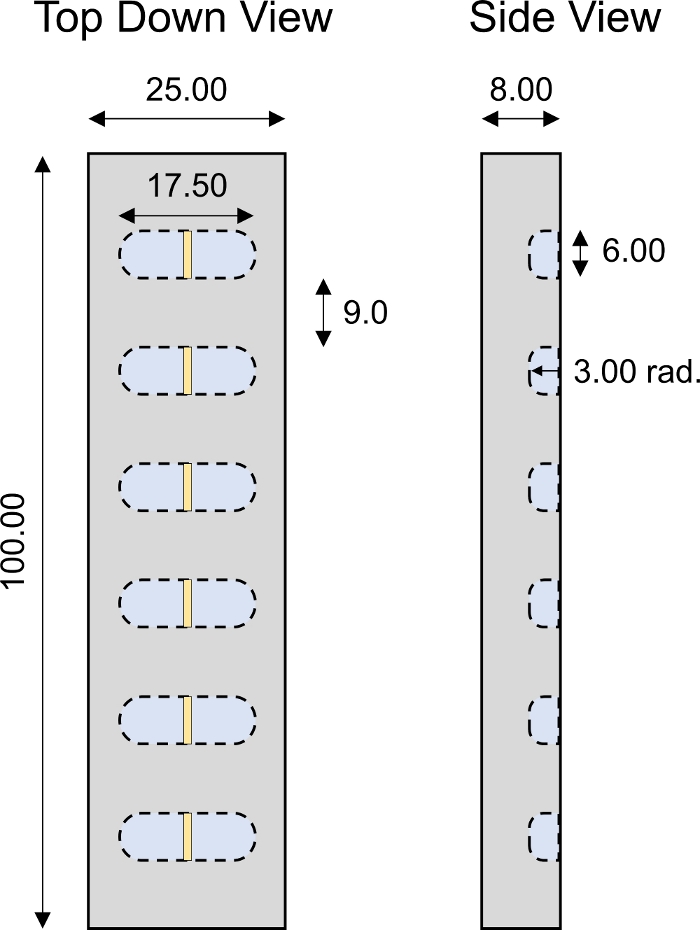
Figure 4: Custom-designed 1-D transport chamber. Design parameters of PMMA 1D transport chamber with 6 individual wells. All numerical values are presented in mm. Please click here to view a larger version of this figure.

Figure 5: Schematic of depth of penetration studies. Cartilage explants (6 mm diameter x 1 mm thickness) were cut in half and fixed to the center of 1-D diffusive transport wells. Fluorescently tagged CPC solution was added to the side of the well in contact with the superficial zone (SZ) of cartilage. 1x PBS-PI was added to the side of the well in contact with the deep zone (DZ) of cartilage. Following diffusion, a cross-section of cartilage (3 mm x 1 mm) was imaged using confocal microscopy. This figure has been modified from Vedadghavami et al.4 and Bajpayee et al.3 Please click here to view a larger version of this figure.
4. Non-equilibrium diffusion rate of CPCs in the cartilage
- Bring the two halves of the custom-designed transport chamber (Figure 6) together to assemble and close the chamber. Use washers, nuts and bolts to tightly close the chamber with a wrench.
NOTE: The transport chamber must be translucent as to not interfere with fluorescent readings. The transport chambers used in this protocol are made from polymethylmethacrylate (PMMA). - Coat the inner space of the chamber with 0.5% w/v non-fat bovine milk solution in 1x PBS (2 mL for each chamber) for 15 min to prevent non-specific binding of CPCs to chamber walls. Then rinse the chamber with 1x PBS (2 mL for each chamber).
- Using the custom-designed slicing fixture (Figure 2) and a razor blade, slice a 6 mm diameter cartilage explant (transverse plane) to a thickness of 500-800 μm, inclusive of the superficial zone. Keep the explant hydrated with 1x PBS.
- Using hammer-driven and dermal punches, create gaskets from rubber sheets as shown in Figure 7.
- Assemble each half transport chamber to include 1 large rubber gasket, 1 PMMA insert and 1 small rubber gasket each. Place the explant in the wells of the plastic insert, with the superficial zone facing the upstream chamber. Sandwich the two halves together to complete the assembly and screw tightly using a wrench (Figure 7).
- Fill the upstream chamber with 2 mL of 1x PBS-PI and observe the downstream chamber for leakage of fluid from the upstream chamber. If leakage is present, reassemble the chamber, adjusting gasket position and tightness of screws. If no leakage, fill the downstream chamber with 2 mL 1x PBS-PI as well.
- Add a mini-stir bar to both up and downstream chambers and place the chamber on a stir plate. Align the chamber so that laser from the spectrophotometer is focused towards the center of the downstream chamber. Place the signal receiver portion of the spectrophotometer behind the downstream chamber (Figure 8).
NOTE: The laser and receiver of the spectrophotometer must be equipped with the appropriate filters to excite, emit and transmit signals from the fluorescently labeled protein. Protect the transport chamber from light using a black box during experimentation to avoid interference in fluorescence signal. It is best practice to seal the openings on top of the chamber with flexible film to avoid evaporation. - Collect real-time downstream fluorescence emission readings and ensure a stable signal for at least 5 min.
NOTE: Aliquots from the downstream chamber can be obtained and assessed for fluorescence using a plate reader if a custom-designed spectrophotometer or translucent transport chamber is not available. - Pipette a pre-calculated volume of stock solution of fluorescently tagged CPCs into the upstream chamber to ensure a final concentration of 3 μM inside the upstream chamber. Observe the downstream fluorescence signal and allow for solute transport to reach a steady increase in slope.
NOTE: A thicker cartilage explant will require longer time to reach steady-state. - Once the steady state has been reached, take 20 μL from the upstream chamber and add to the downstream chamber (“spike test”).
NOTE: A spike in the downstream fluorescence will be observed. This will allow for correlation between fluorescence readings and CPC concentration. - Collect real-time downstream fluorescence readings.
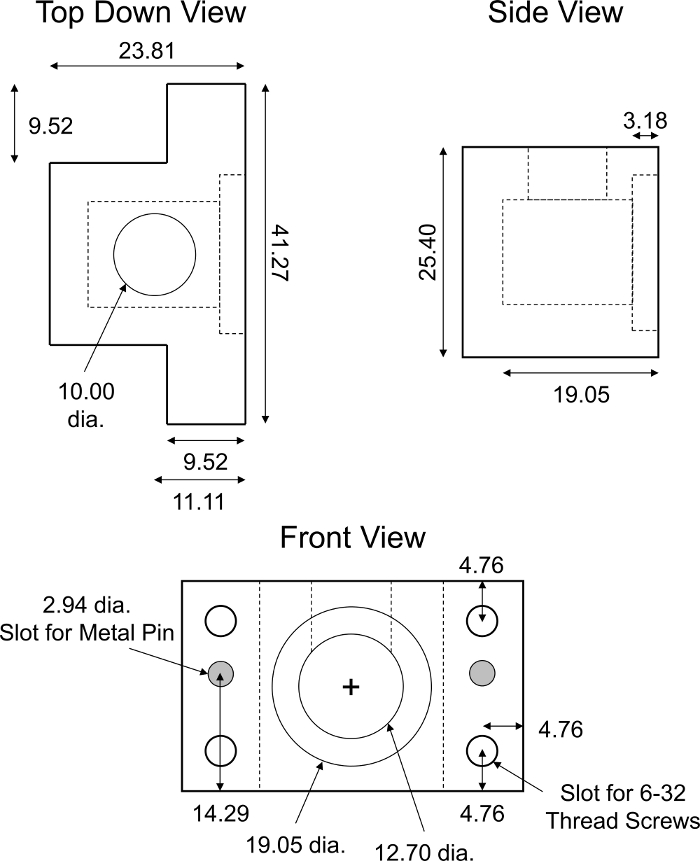
Figure 6: Custom-designed non-equilibrium diffusion transport chamber. Design parameters of PMMA non-equilibrium diffusion transport chamber. The chamber must be translucent as to not interfere with fluorescence readings. The complete transport chamber consisted of two identical halves of the fixture shown. Two cylindrical stainless-steel pins (~2.94 mm diameter, ~18 mm long) were required to ensure alignment and complete closure of the halves of the chamber. Four identical slots for 6-32 thread screws were made in each corner of the chamber for screw tight assembly. All numerical values are presented in millimeters. Please click here to view a larger version of this figure.
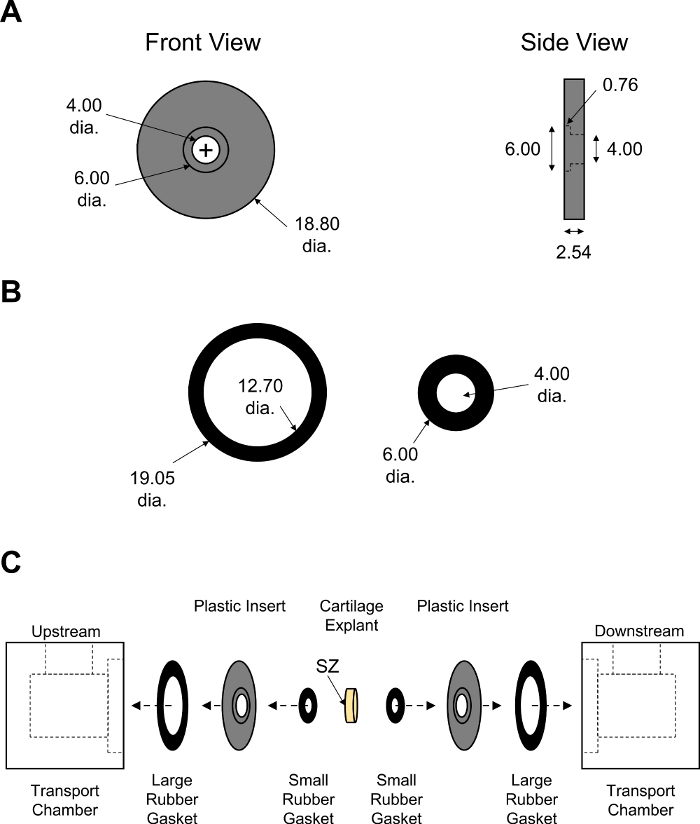
Figure 7: Assembly of non-equilibrium diffusion transport chamber. Design parameters of (A) black PMMA inserts and (B) large and small rubber gaskets. Thickness of rubber gaskets was adjusted to ensure tight closure of the chamber. All numerical values are presented in mm. (C) Schematic showing the order of assembly for two halves of transport chamber with cartilage explant placed in the center. SZ indicates superficial zone of cartilage which was facing the upstream chamber. Please click here to view a larger version of this figure.
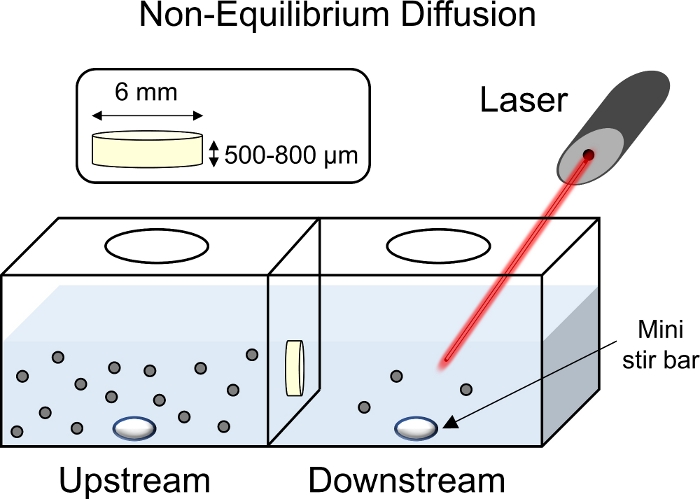
Figure 8: Schematic of non-equilibrium diffusion experiments. Cartilage explants (6 mm diameter x 1 mm thickness) were placed in the center of the transport chamber with the superficial surface facing the upstream chamber. Both up and downstream sides of the chamber were filled with 1x PBS-PI and mixed using a mini stir bar. With a laser pointed towards the downstream chamber to collect fluorescent readings, fluorescently tagged CPC solution was added to the upstream chamber. Please click here to view a larger version of this figure.
Wyniki
Following equilibrium absorption of CPCs by cartilage, the bath fluorescence decreases when the solute has been uptaken by the tissue. However, if the fluorescence value of the final bath remains similar to the initial, it indicates that there is no/minimal solute uptake. Another confirmation of solute uptake is if the tissue has visibly changed color to the color of the fluorescent dye. The quantitative uptake of solutes in cartilage was determined using the uptake ratio (RU) after the fluorescence values were converted to concentration using the standard curve. Using the initial bath concentration (CBath,i) and the equilibrium bath concentration (CBath), the solute concentration inside cartilage (CCartilage) was calculated as follows where VBath=300 μL:

Using CCartilage and CBath, the uptake ratio was determined using the equation below.

Values >>1 indicate enhanced uptake due to charge interactions, whereas values <1 indicate low uptake. For example, larger, neutral solutes such as Neutravidin (60 kDa, pI 7) have shown RU<1 due to steric hinderance with the cartilage matrix1, while smaller, neutral solutes are expected to show RU~1, as they are able to diffuse into the cartilage, reaching equilibrium. In contrast, Avidin (pI 10.5), the positively charged counterpart of Neutravidin, has shown an RU~180 in cartilage1. Further, small-sized CPCs (~2.5-4 kDa) show an RU up to 4004. As shown by Figure 9, the uptake ratios showed a charge-dependent response4.
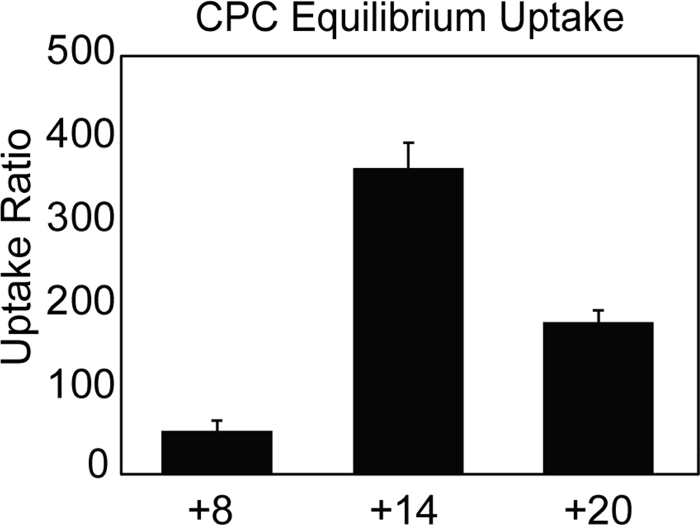
Figure 9: Representative results of equilibrium uptake of CPCs in cartilage. CPCs of varying net charge (+8, +14 and +20) and their respective uptake ratios in cartilage revealed that uptake does not increase monotonically with increasing charge. This figure has been modified from Vedadghavami et al.4 Please click here to view a larger version of this figure.
In case the fluorescence of the bath has increased after reaching equilibrium, this would indicate that the initial bath concentration of the fluorescently tagged solute was too high. This would cause the emission to be trapped within the solution after excitation via plate reader. To solve this issue, lower the initial bath concentration.
Following confocal imaging, a stack of images was produced with each image showing the depth of penetration of fluorescently tagged CPCs at different layers of cartilage. The image obtained from the center of the cartilage explant showed the furthest depth of penetration compared to any other image throughout the thickness of the explant. Using a software like ImageJ, the stack of images was overlaid to produce one image displaying the average intensity of CPC penetration. These overlaid images provided the best comparison of overall depth of penetration between variously charged drug carriers. A charge-dependent response was observed for CPCs within the tissue (Figure 10). Large neutrally charged carriers (e.g., Neutravidin) will not penetrate much farther than the superficial zone as they lack the ability to use charge interactions to induce binding with the matrix1. Similarly, too high a positive charge will be limited to the superficial zone (as shown by CPC+20 even after 24 h)4, however, this is a result of the carrier being bound too strongly to the matrix; they are unable to unbind from their initial target. An optimally charged drug carrier would, however, be able to penetrate through to the deep zones of cartilage as it can take advantage of the weak and reversible nature of electrostatic interactions (as shown by CPC+14)4. This allows for the carrier to bind to its initial target, unbind to move deeper through the matrix, and then bind again to targets further inside the tissue. For example, Avidin (~7 nm diameter, 66 kDa, pI 10.5) binding with negatively charged matrix glycosaminoglycans (GAGs) has a dissociation constant (KD) of 150 μM, which was considered to be weak enough to enable the reversible binding necessary for full thickness penetration1. Despite the weak binding, Avidin showed high retention and uptake in cartilage due to the presence of a high density of negatively charged GAGs (Binding density NT = 2900 μM)1. Further, as shown by CPC+8, full thickness penetration was visible within 4 h, while CPC+14 required 24 h to reach full depth4. Thus, multiple time points should be chosen to effectively compare rate of different solutes at penetrating tissue thickness. For a more quantitative understanding of the depth of penetration, the relative intensities of solutes along the thickness of tissue can be obtained using ImageJ.
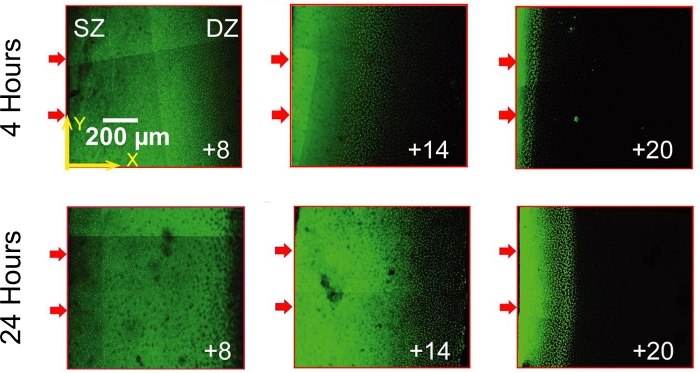
Figure 10: Representative results from depth of penetration studies in cartilage. CPCs of varying net charge (+8, +14 and +20) and their respective depth of penetration through cartilage revealed weak-reversible binding as seen by CPC+8 and CPC+14 is key for full depth penetration. However, too strong binding as seen for CPC+20 impeded full thickness penetration. This figure has been modified from Vedadghavami et al.4 Please click here to view a larger version of this figure.
If no fluorescent signal has been observed inside the cartilage during imaging, two issues can be present; either the surface area for diffusion was blocked by the epoxy, or the initial bath concentration was too low to produce a fluorescent signal. To fix these issues, remove excess epoxy from the cartilage surfaces and increase solute concentration.
Non-equilibrium diffusion transport experiments resulted in a curve as shown in Figure 11. The initial part of the curve represents solute diffusion through cartilage as solute-matrix binding interactions take place. With increased charge of the carrier, stronger matrix binding occurred which will result in a longer time for solutes to reach the downstream chamber. Once solutes penetrated through the depth of the cartilage and reached the downstream chamber, an increase in slope of the curve was observed as the fluorescence reading increased over time. This second part of the curve reached a steady slope, representing steady-state diffusion. A tangential line was drawn at the steady-state slope to determine the time it takes to reach steady-state diffusion (τLag), marked by the x-intercept. The effective diffusivity (DEFF), the diffusion rate of CPCs while there are binding interactions present in cartilage, was calculated using the τLag and explant thickness (L) as follows:

Following transfer of 20 μL of solution from the upstream to downstream chamber, a spike in fluorescence was observed; the resulting stabilized fluorescence intensity was used for correlation to the concentration. The concentration of CPCs in downstream (CD) normalized to the upstream concentration (CU) was then plotted against time. The slope of this curve was used to estimate the steady-state diffusion rate when all binding sites in cartilage are occupied (DSS) as shown below. This value was inclusive of the partitioning coefficient. Here, φ, VD and A represent cartilage porosity (~0.8), downstream chamber volume (2 mL) and cross-sectional area of cartilage (0.1257 cm2), respectively. Representative DEFF and DSS values calculated from non-equilibrium transport experiments for CPCs can be found in Table 1.


Figure 11: Representative results from non-equilibrium diffusion studies through cartilage. CPC+8 diffusion curve, plotted as the downstream concentration (CD) normalized to the upstream concentration (CU), against time. A tangential line drawn at the steady-state slope (blue) crosses the x-axis at τLag, which was used to calculate DEFF. The slope of the tangent was used to calculate DSS. The spike test (gray) represents the stabilized concentration in the downstream chamber following transfer of 20 μL CPC solution from upstream to downstream, used for normalizing downstream concentration. This figure has been modified from Vedadghavami et al.4 Please click here to view a larger version of this figure.
If the downstream fluorescence fails to stabilize prior to the addition of fluorescently tagged peptide to the upstream chamber, it is likely that there is solute residue stuck on the walls from a previous experiment. In this case, disassemble the chamber and wash with soap and sonicate. If there is an increase in the downstream fluorescence immediately following the addition of fluorescently tagged peptide to the upstream chamber, this could indicate that leakage is present. This would require reassembly of the transport chamber and re-testing for leaks. If the downstream fluorescence signal reaches a plateau as opposed to a steady-state increase, it indicates a possible loss of concentration in the upstream chamber, likely caused by solutes sticking to the walls of the chamber. Addition of 0.005% w/v bovine serum albumin (BSA) to the upstream chamber can help prevent sticking.
| CPC | DEFF (cm2/s) | DSS (cm2/s) |
| CPC+8 | 1.7 ± 0.4 x 10-7 | 5.8 ± 0.0 x 10-5 |
| CPC+14 | 9.8 ± 0.2 x 10-8 | 2.6 ± 1.2 x 10-5 |
| CPC+20 | 4.7 ± 0.1 x 10-8 | 1.4 ± 0.9 x 10-5 |
Table 1: Representative DEFF and DSS values for CPC transport through cartilage. This table has been modified from Vedadghavami et al.4
Dyskusje
The methods and protocols described here are significant to the field of targeted drug delivery to negatively charged tissues. Due to the high density of negatively charged aggrecans present in these tissues, a barrier is created, thus preventing drugs from reaching their cellular target sites which lie deep within the matrix. To address this outstanding challenge, drugs can be modified to incorporate positively charged drug carriers which can enhance the transport rate, uptake and binding of drugs within tissue1,3,4,14,15,16,17,18,19. As shown here with the developed methods, the transport of positively charged drug carriers can be characterized to determine the equilibrium uptake, depth of penetration and non-equilibrium diffusion rate. We have successfully designed three separate experimental setups which can be utilized for assessing the transport through cartilage explants.
For the successful characterization of transport, critical steps in the procedure need to be followed. The use of protease inhibitors (PIs) in all solutions is critical for accurately characterizing intra-cartilage transport of CPCs through cartilage as they function to prevent enzymatic digestion of proteins in tissue20. Therefore, if not used, cartilage matrix components such as aggrecans and collagen can begin to degrade and secrete into the surrounding bath during experimentation. This can greatly lower the FCD of cartilage, reducing the number of charge-based binding sites in the cartilage matrix. The resulting tissue would no longer be representative of healthy cartilage. Conversely, the experiments presented can also be used to evaluate the transport of CPCs through arthritic cartilage where the aggrecan content is much lower as seen in OA20. Using trypsin or Chondroitinase ABC to digest cartilage explants, the aggrecan density can be controlled, thereby allowing for the evaluation of transport and drug delivery in a diseased state. In this case, charge-based binding may be compromised, while other types of interactions such as hydrogen bonds and hydrophobic interactions synergistically enhance intra-cartilage binding and retention4.
Maintaining hydration of the cartilage explant is the key during sample preparation and experimentation. Dehydration via exposure to air for greater than 6 minutes has been shown to induce irreversible damage to articular cartilage21. As a result, unexpected changes in the transport of CPCs may occur. Similarly, evaporation of CPC baths can result in explant dehydration; this can be prevented by sealing with a flexible film. However, bath evaporation can not only cause explant dehydration, but it can also cause a change in CPC bath concentration, resulting in false fluorescent readings. Further it is important to note that depth of penetration studies require thin cross-sections (~100 μM) of cartilage to be imaged. This is a technique which requires practice so that slices of uniform thickness can be obtained. It is also critical for non-equilibrium diffusion experiments, that the transport chamber be translucent so that real-time fluorescence measurements can be obtained with the custom-designed spectrophotometer. However, as an alternative, aliquots from the downstream chamber can be obtained and assessed for fluorescence using a plate reader or other spectrophotometric reader.
The methods presented here are of great significance as they provide a bench-scale method for characterizing drug carrier transport through the cartilage in order to better predict in vivo drug retention and long-term biological efficacy. Recently, a finite element framework for computational fluid dynamics was implemented for measuring solute transport through porous media22. Arbabi et al. have used finite element analysis in combination with experimental data obtained from micro-CT imaging to measure diffusion rates of negatively charged contrast agent, ioxaglate in cartilage23,24. Further, using a multi-zone, multi-phasic model, the diffusion coefficients of ioxaglate in different zones of cartilage were measured along with the FCD of each zone. While micro-CT imaging can only be used with contrast agents, our experimental setup allows for the characterization of transport of all drugs and drug carriers that can be fluorescently labeled. However, the advanced computation modeling used by Arbabi et al. provides a more comprehensive analysis of solute transport behavior and may be applied to our experimental methods13,24.
A limitation of the presented method is that the experimental setup for each solute transport experiment does not fully encompass the in vivo environment. Biological responses and mechanical and dynamic forces that occur within the natural joint are not simulated here. To incorporate these forces, the transport chamber can be modified with a piston to simulate convective flow patterns that occur during activities as walking and running. However, while convective flow can increase uptake by 2-fold, uptake due to electrostatic interactions can increase 100-400x. Thus, the experimental setups presented here provide a good estimate for charge-based transport and uptake25. Further, since the knee joint naturally contains synovial fluid, it can be used in the bath solutions for transport experiments instead of 1x PBS-PI. It is estimated that the uptake of cationic carriers in cartilage would decrease in synovial fluid compared to in 1x PBS due to the presence of hyaluronan chains with negatively charged carboxyl groups in synovial fluid. It is possible that cationic carriers competitively bind with the hyaluronan chains of the synovial fluid in addition to the GAGs of cartilage. However, the density of negatively charged groups is significantly higher in cartilage compared to synovial fluid, due to the presence of both negatively charged carboxylated hyaluronan chains and sulfated GAGs in cartilage15. Thus, although the uptake in cartilage in presence of synovial fluid will be lower than in 1x PBS, it is still expected to maintain high intra-cartilage uptake. In vivo, Avidin has shown high intra-cartilage uptake in both rat and rabbit cartilage in presence of synovial fluid16,26. Further, Avidin has shown high uptake and retention in cartilage up to 2 weeks following intra-articular injection in a rabbit anterior cruciate ligament transection model27.
Use of bovine cartilage in this system allows for a more accurate representation of drug penetration through cartilage due to its similarities to human cartilage in terms of thickness (~1.5-2 mm)28,29. Transport of solutes through the cartilage can vary with thickness; drug carriers may require fewer binding interactions to fully penetrate through mice or rat cartilage which are much thinner, however can significantly be hindered from penetrating deeper in thicker human cartilage1. Further, although these experiments were designed to characterize solute transport within the cartilage, these methods can be modified and applied to other negatively charged tissues such as meniscus, cornea and vitreous humor of the eye, and the nucleus pulposus of intervertebral disks. The methodologies of experiments designed here are advantageous as the dimensions of fixtures and transport chambers can be adapted according to the size and species of tissue. The impact of these methods is widespread, limited not only to drug carriers but also for the evaluation of transport of drugs and drug-drug carrier conjugates.
Ujawnienia
The authors have nothing to disclose.
Podziękowania
This work was funded by the United States Department of Defense through the Congressionally Directed Medical Research Programs (CDMRP) under contract W81XWH-17-1-0085, and the National Institute of Health R03 EB025903-1. AV was funded by the College of Engineering Dean’s Fellowship at Northeastern University.
Materiały
| Name | Company | Catalog Number | Comments |
| 316 Stainless Steel SAE Washer | McMaster-Carr | 91950A044 | For number 5 screw size, 0.14" ID, 0.312" OD |
| 96-Well Polystyrene Plate | Fisherbrand | 12566620 | Black |
| Acrylic Thick Gauge Sheet | Reynolds Polymer | N/A | For non-equilibrium diffusion and 1-D diffusion transport chamber |
| Antibiotic-Antimycotic | Gibco | 15240062 | 100x |
| Bovine Cartilage | Research 87 | N/A | 2-3 weeks old, femoropatellar groove |
| Bovine Serum Albumin | Fisher BioReagents | BP671-1 | |
| CPC+14 | LifeTein | LT1524 | Custom designed peptide |
| CPC+20 | LifeTein | LT1525 | Custom designed peptide |
| CPC+8 | LifeTein | LT1523 | Custom designed peptide |
| Delicate Task Wipers | Kimberly-Clark Professional | 34155 | |
| Dermal Punch | MedBlades | MB5-1 | 3, 4 and 6 mm |
| Economy Plain Glass Microscope Slides | Fisherbrand | 12550A3 | |
| Flat Bottom Cell Culture Plates | Corning Costar | 3595 | Clear, 96 well |
| Flexible Wrapping Film | Bemis Parafilm M Laboratory | 1337412 | |
| Gold Seal Cover Glass | Electron Microscopy Sciences | 6378701 | # 1.5, 18x18 mm |
| Hammer-Driven Hole Punch | McMaster-Carr | 3427A15 | 1/2" Diameter |
| Hammer-Driven Hole Punch | McMaster-Carr | 3427A19 | 3/4" Diameter |
| Laser | Chroma Technology | AT480/30m | Spectrophotometer Laser Light |
| Low-Strength Steel Hex Nut | McMaster-Carr | 90480A007 | 6-32 Thread size |
| LSM 700 Confocal Microscope | Zeiss | LSM 700 | |
| Micro Magnetic Stirring Bars | Bel-Art Spinbar | F37119-0007 | 7x2 mm |
| Multipurpose Neoprene Rubber Sheet | McMaster-Carr | 1370N12 | 1/32" Thickness |
| Non-Fat Dried Bovine Milk | Sigma Aldrich | M7409 | |
| Petri Dish | Chemglass Life Sciences | CGN1802145 | 150 mm diameter |
| Phosphate-Buffered Saline | Corning | 21-040-CMR | 1x |
| Plate Shaker | VWR | 89032-088 | |
| Protease Inhibitors | Thermo Scientific | A32953 | |
| Razor Blades | Fisherbrand | 12640 | |
| R-Cast Acrylic Thin Gauge Sheet | Reynolds Polymer | N/A | Black transport chamber inserts |
| RTV Silicone | Loctite | 234323 | Epoxy, Non-corrosive, clear |
| Scalpel | TedPella | 549-3 | #10, #11 blades |
| Signal Receiver | Chroma Technology | ET515lp | Spectrophotometer Laser Signal Receiver |
| Snap-Cap Microcentrifuge Tubes | Eppendorf | 22363204 | 1.5 mL |
| Spatula | TedPella | 13508 | |
| Synergy H1 Microplate Reader | Biotek | H1M | |
| Zinc-Plated Alloy Steel Socket Head Screw | McMaster-Carr | 90128A153 | 6-32 Thread size, 1" Long |
Odniesienia
- Bajpayee, A. G., Grodzinsky, A. J. Cartilage-targeting drug delivery: can electrostatic interactions help. Nature Reviews Rheumatology. 13 (3), 183-193 (2017).
- Maroudas, A. Transport of solutes through cartilage: permeability to large molecules. Journal of Anatomy. 122, 335-347 (1976).
- Bajpayee, A. G., Wong, C. R., Bawendi, M. G., Frank, E. H., Grodzinsky, A. J. Avidin as a model for charge driven transport into cartilage and drug delivery for treating early stage post-traumatic osteoarthritis. Biomaterials. 35 (1), 538-549 (2014).
- Vedadghavami, A., et al. Cartilage penetrating cationic peptide carriers for applications in drug delivery to avascular negatively charged tissues. Acta Biomaterialia. 93, 258-269 (2019).
- Mehta, S., Akhtar, S., Porter, R. M., Önnerfjord, P., Bajpayee, A. G. Interleukin-1 receptor antagonist (IL-1Ra) is more effective in suppressing cytokine-induced catabolism in cartilage-synovium co-culture than in cartilage monoculture. Arthritis Research & Therapy. 21 (1), 238 (2019).
- Vedadghavami, A., Zhang, C., Bajpayee, A. G. Overcoming negatively charged tissue barriers: Drug delivery using cationic peptides and proteins. Nano Today. 34, 100898 (2020).
- Young, C. C., Vedadghavami, A., Bajpayee, A. G. Bioelectricity for Drug Delivery: The Promise of Cationic Therapeutics. Bioelectricity. , (2020).
- Felson, D. T. Osteoarthritis of the knee. New England Journal of Medicine. 354 (8), 841-848 (2006).
- Wieland, H. A., Michaelis, M., Kirschbaum, B. J., Rudolphi, K. A. Osteoarthritis - An untreatable disease. Nature Reviews Drug Discovery. 4 (4), 331-344 (2005).
- Martel-Pelletier, J. Pathophysiology of osteoarthritis. Osteoarthritis and Cartilage. 7 (4), 371-373 (1999).
- Sophia Fox, A. J., Bedi, A., Rodeo, S. A. The basic science of articular cartilage: Structure, composition, and function. Sports Health. 1 (6), 461-468 (2009).
- Chevalier, X., et al. Intraarticular injection of anakinra in osteoarthritis of the knee: A multicenter, randomized, double-blind, placebo-controlled study. Arthritis Care and Research. 61 (3), 344-352 (2009).
- Cohen, S. B., et al. A randomized, double-blind study of AMG 108 (a fully human monoclonal antibody to IL-1R1) in patients with osteoarthritis of the knee. Arthritis Research and Therapy. 13 (4), 125 (2011).
- Evans, C. H., Kraus, V. B., Setton, L. A. Progress in intra-articular therapy. Nature Reviews Rheumatology. 10 (1), 11-22 (2014).
- He, T., et al. Multi-arm Avidin nano-construct for intra-cartilage delivery of small molecule drugs. Journal of Controlled Release. 318, 109-123 (2020).
- Bajpayee, A. G., Scheu, M., Grodzinsky, A. J., Porter, R. M. A rabbit model demonstrates the influence of cartilage thickness on intra-articular drug delivery and retention within cartilage. Journal of Orthopaedic Research. 33 (5), 660-667 (2015).
- Bajpayee, A. G., Quadir, M. A., Hammond, P. T., Grodzinsky, A. J. Charge based intra-cartilage delivery of single dose dexamethasone using Avidin nano-carriers suppresses cytokine-induced catabolism long term. Osteoarthritis and Cartilage. 24 (1), 71-81 (2016).
- Zhang, C., et al. Avidin-biotin technology to synthesize multi-arm nano-construct for drug delivery. MethodsX. , 100882 (2020).
- Wagner, E. K., et al. Avidin grafted dextran nanostructure enables a month-long intra-discal retention. Scientific Reports. 10.1, 1-14 (2020).
- Troeberg, L., Nagase, H. Proteases involved in cartilage matrix degradation in osteoarthritis. Biochimica et Biophysica Acta - Proteins and Proteomics. 1824 (1), 133-145 (2012).
- Kirk, T. B., Wilson, A. S., Stachowiak, G. The effects of dehydration on the surface morphology of articular cartilage. Journal of Orthopaedic Rheumatology. 6 (2-3), 75-80 (1993).
- Ateshian, G. A., Maas, S., Weiss, J. A. Solute transport across a contact interface in deformable porous media. Journal of Biomechanics. 45 (6), 1023-1027 (2012).
- Arbabi, V., Pouran, B., Weinans, H., Zadpoor, A. A. Multiphasic modeling of charged solute transport across articular cartilage: Application of multi-zone finite-bath model. Journal of Biomechanics. 49 (9), 1510-1517 (2016).
- Arbabi, V., Pouran, B., Zadpoor, A. A., Weinans, H. An experimental and finite element protocol to investigate the transport of neutral and charged solutes across articular cartilage. Journal of Visualized Experiments. 2017 (122), (2017).
- Sampson, S. L., Sylvia, M., Fields, A. J. Effects of dynamic loading on solute transport through the human cartilage endplate. Journal of Biomechanics. 83, 273-279 (2019).
- Bajpayee, A. G., Scheu, M., Grodzinsky, A. J., Porter, R. M. Electrostatic interactions enable rapid penetration, enhanced uptake and retention of intra-articular injected avidin in rat knee joints. Journal of Orthopaedic Research : Official Publication of the Orthopaedic Research Society. 32 (8), 1044-1051 (2014).
- Bajpayee, A. G., et al. Sustained intra-cartilage delivery of low dose dexamethasone using a cationic carrier for treatment of post traumatic osteoarthritis. European Cells & Materials. 34, 341-364 (2017).
- Malda, J., et al. Of Mice, Men and Elephants: The Relation between Articular Cartilage Thickness and Body Mass. PLoS One. 8 (2), 57683 (2013).
- Frisbie, D. D., Cross, M. W., McIlwraith, C. W. A comparative study of articular cartilage thickness in the stifle of animal species used in human pre-clinical studies compared to articular cartilage thickness in the human knee. Veterinary and Comparative Orthopaedics and Traumatology. 19 (3), 142-146 (2006).
Przedruki i uprawnienia
Zapytaj o uprawnienia na użycie tekstu lub obrazów z tego artykułu JoVE
Zapytaj o uprawnieniaThis article has been published
Video Coming Soon
Copyright © 2025 MyJoVE Corporation. Wszelkie prawa zastrzeżone